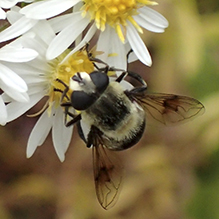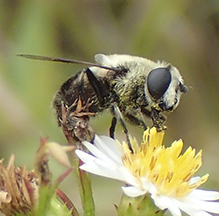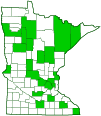orange-spotted drone fly
(Eristalis anthophorina)
Conservation • Description • Habitat • Ecology • Distribution • Taxonomy
|
|
||||||||||||||
Description |
Orange-spotted drone fly is a common, hairy, medium-sized hoverfly. It occurs in Europe and North America. North American and European specimens have been closely examined and found identical. This suggests that either the species is holarctic, occurring around the Northern Hemisphere, or it is native to Europe and was introduced into North America. In the United States, orange-spotted drone fly occurs in the east from Maine to Pennsylvania, west to Minnesota and Illinois; on the West Coast from Washington to northern California; and in Idaho, Wyoming, Colorado, and New Mexico. In Canada it occurs across the south from Nova Scotia to British Columbia, and north along the West Coast to Alaska. It is common in Minnesota. Adults are active from early April to mid-November in other areas, early May to mid-September in Minnesota. They are found in a variety of wetland habitats, including fens and bogs, and in woodland pools. They feed on flower nectar. The larvae live in water and feed on submerged, rotting, plant litter. Adults are robust and ⅜″ to ⅝″ (9.3 to 15.1 mm) in length. They closely resemble bumble bees, and they are considered bumble bee mimics. The head is hemispherical and slightly broader than the thorax. There are two large compound eyes on the sides of the head and three small simple eyes (ocelli) in a triangle on top of the head. The compound eyes are thickly covered with short, black, erect hairs. On the male, the eyes meet for a short distance at the top of the head. On the female they do not. They are not spotted or banded. The face is not projected forward. When viewed from the side it is almost straight down. It is densely covered with loose, medium-length, yellow hairs except for a bare, shiny, black stripe in the middle. The antennae are short and are inserted near the middle of the head. They are dark brownish-black and have just three segments. The first and second segments are short. The third segment is flat and longest on the bottom, shorter and rounded on top. At the base of the third segment there is a long, forward-pointing bristle (arista) on the upper side. The arista has very short to microscopic hairs near the base, but it is otherwise bare, not feather-like (plumose). The protruding mouthpart (proboscis) is short and fleshy. The thorax is dark blackish-brown, shiny, and densely covered with long, erect, yellowish hairs. It has three segments. Each segment has four principal exoskeletal plates, one above, one below, and one on each side. The upper (dorsal) plates, from front to rear, are the prescutum, scutum, and scutellum. Pale longitudinal stripes on the scutum, if present, are very obscure. There is a convex swelling, called the posterior callus or postalar callus, on the upper rear corners of the scutum. The hairs on the sides of each posterior callus are yellow. The scutellum is shiny, yellow to brownish, and almost translucent. It is densely covered with yellow erect hairs. The abdomen is black and is densely covered with erect, medium-length, yellow hairs. It has five segments. The first segment is narrow and entirely black. The second segment has an orange spot on each lateral margin. This is the feature that gives the fly its common name. The third and fourth segments may have similar spots, the spots may be smaller, or they may be entirely black. The legs are mostly black. On the front and middle legs, the very tip of the third segment (femur) and the base of the fourth segment (tibia) are yellowish. On the hind legs, the basal half of the tibia is yellowish. The last part of the leg (tarsus), corresponding to the foot, has five segments. They are all black except for the middle leg, where only the first tarsal segment is yellow. The wings are mostly clear except for a diffuse brown cloud near the middle. There is a spurious vein between the radius (R) and media (M) veins. The R4+5 vein is deeply bent (sinuous), appearing “bumped” downward in the middle. The anal cell is long and is closed near the wing margin. The marginal, R1, R5, and M2 cells are also closed. |
Size |
Total length: ⅜″ to ⅝″ (9.3 to 15.1 mm) |
Similar Species |
Habitat |
Wetland habitats, including fens and bogs, and woodland pools |
Ecology |
Season |
|
Behavior |
|
Life Cycle |
Females have been found in large groups passing the winter in crevices and holes in sandstone caves near St. Paul, Minnesota. |
Larva Food |
Submerged plant litter |
Adult Food |
Flower nectar |
Distribution |
||
|
Sources Telford, Horace S.. (1939). The Syrphidae of Minnesota. University of Minnesota. Minnesota Agricultural Experiment Station. |
|
| 4/13/2024 | ||
Occurrence |
||
|
||
Taxonomy |
|
Order |
|
Suborder |
Brachycera |
Infraorder |
Cyclorrhapha |
Zoosection |
Aschiza |
Family |
Syrphidae (Hover Flies) |
Subfamily |
Eristalinae (Drone Flies and Allies) |
Tribe |
Eristalini (Rat-tail Maggot Flies) |
Subtribe |
Eristalina |
Genus |
|
Subgenus |
Eoseristalis |
Subordinate Taxa |
|
|
|
Synonyms |
|
Eoseristalis anthophorina Eristalis bastardii Eristalis everes Eristalis mellisoids Eristalis mellissoides Eristalis montanus Eristalis nebulosus Eristalis occidentalis Eristalis perplexus Eristalis pterelas Eristalis semimetallicus Eristalis toyohare Eristalis toyoharensis Eristalomyia luleoensis Syrphus anthophorinus Syrphus nitidiventris |
|
Common Names |
|
orange-spotted drone fly |
|
Glossary
Femur
On insects and arachnids, the third, largest, most robust segment of the leg, coming immediately before the tibia. On humans, the thigh bone.
Ocellus
Simple eye; an eye with a single lens. Plural: ocelli.
Scutellum
The exoskeletal plate covering the rearward (posterior) part of the middle segment of the thorax in some insects. In Coleoptera, Hemiptera, and Homoptera, the dorsal, often triangular plate behind the pronotum and between the bases of the front wings. In Diptera, the exoskeletal plate between the abdomen and the thorax.
Scutum
The forward (anterior) portion of the middle segment of the thorax (mesonotum) in insects and some arachnids.
Spurious vein
A longitudinal, thickened line between the radius and media veins. It resembles a true vein but is not connected to any other veins.
Tarsus
On insects, the last two to five subdivisions of the leg, attached to the tibia; the foot. On spiders, the last segment of the leg. Plural: tarsi.
Tibia
The fourth segment of an insect leg, after the femur and before the tarsus (foot). The fifth segment of a spider leg or palp. Plural: tibiae.
Visitor Photos |
||
Share your photo of this insect. |
||
This button not working for you? |
||
Babette Kis |
||
Eristalis anthophorina (orange-spotted drone fly) Eristalis anthophorina (orange-spotted drone fly) photos taken at Barnes Prairie, Racine Co., WI on October 11, 2022. These cute flies superficially resemble bumblebees. This one, a female, was about the size of a small worker bumblebee. I could tell that it wasn't a bumblebee (at a distance), as it darted quickly from flower to flower. |
||
 |
|
|
MinnesotaSeasons.com Photos |
||
|
||
|
||

Visitor Videos |
||
Share your video of this insect. |
||
This button not working for you? |
||
|
Other Videos |
||
Hover Fly (Syrphidae: Eristalis anthophorina) on Dandelion |
About
May 9, 2011 The first of the bumble bee mimics appear with the dandelion blossoms this week. Photographed at Fisher, Minnesota (09 May 2011). |
Hover Fly (Syrphidae: Eristalis anthophorina) on Blossom |
About
Aug 11, 2010 Photographed at the Rydell NWR, Minnesota (10 August 2010). Thank you to Martin Hauser (@ Bugguide.net) for identifying this specimen! |

Visitor Sightings |
||
Report a sighting of this insect. |
||
This button not working for you? |
||
MinnesotaSeasons.com Sightings |
||
|

|
Created: 4/14/2024 Last Updated: © MinnesotaSeasons.com. All rights reserved. |




